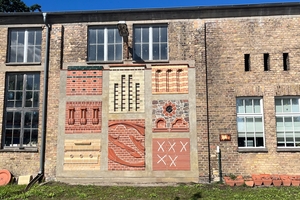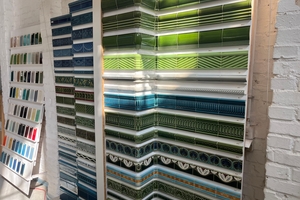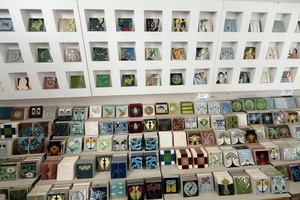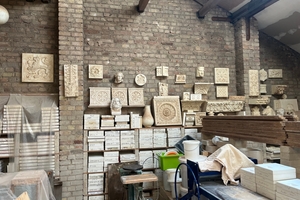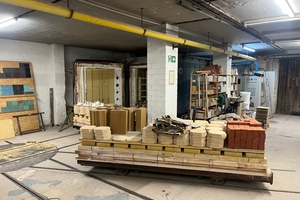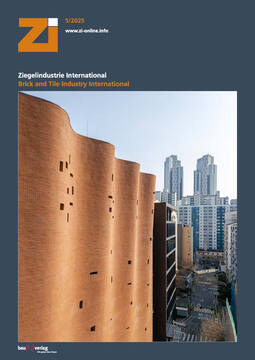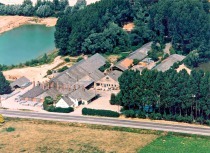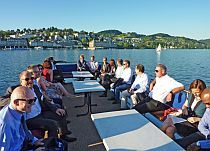From a small village in Brandenburg to worldwide recognition
In Sieversdorf and surrounding villages, a rural and somewhat remote part of the German federal state Brandenburg between Fürstenwalde and Frankfurt (Oder), there is a ‘hidden champion’ of architectural ceramics: GOLEM – Kunst und Baukeramik GmbH. The manufacturing company sells ceramic bricks and tiles worldwide with great success and without competition. How was a craft business in a highly industrialised sector able to develop so strongly in the wake of reunification in East Germany? Zi editor Victor Kapr visited the facility in Petersdorf and spoke to Richard Soltau, member of the management board of GOLEM.
Products
GOLEM – Kunst und Baukeramik GmbH manufactures building ceramics in its factory. The product range covers the entire spectrum of building ceramics – roof tiles, ridge tiles, bricks, moulded bricks, tiles, facade elements, etc. – and is divided into two areas.
On the one hand, GOLEM manufactures architectural ceramic elements for the restoration and renovation of historic buildings. These are mostly moulded and special bricks as well as facade elements in small quantities.
Rarely, explains Soltau, does GOLEM supply all the bricks for a building. In the 1990s, the company still produced series bricks in imperial and monastery formats with a historic appearance, such as kiln-fired or tumbled, for restoration projects. At that time, the brick industry did not yet cover this segment. Nowadays, the industry serves these segments and GOLEM concentrates on moulded bricks in very small batch sizes. Several hundred different bricks were produced for the restoration of the Gethsemane Church in Berlin. The balusters and capitals around the main tower of the Berlin Palace were also made by the company, as were around a quarter of a million glazed facing bricks and moulded bricks in over twenty variants for the inner courtyards of the Berlin State Library site at Unter den Linden, which was renovated in 2019.
On the other hand, GOLEM manufactures wall and floor tiles in series. The focus is on the Wilhelminian era, Art Nouveau and Art Deco.
The range of Art Nouveau tiles consists entirely of replicas of historical originals. None of them are designed in-house. There is no need to do so, as the pool of 19th-century ceramics is large enough. GOLEM covers only a small part of this, including around 400 tile designs in various colours, as well as all borders, skirting boards and plastic elements in 70 different glaze colours. This results in around 40,000 items that can be combined in many different ways thanks to their standardised dimensions.
Soltau explains that they have developed this range over many years of restoration work and owe it to this work. Developing it themselves or even deriving it from existing examples would not be possible given the effort involved. That is why GOLEM is the only supplier of Art Nouveau tiles on the market. With this product range, they are not in competition with large industrial companies.
Company history – finding a niche
In the period after the fall of the Berlin Wall, there was a rapidly growing demand for historical building ceramics in the new federal states in order to restore and renovate churches and town halls after decades of neglect. Tomas Grzimek, a ceramist working in the Oderbruch region, founded GOLEM GbR together with Ulrich Schumann to meet the demand for historical bricks and ceramics using manufacturing processes that had been partly forgotten. The initial job creation project turned into a company, and the first employees were unemployed ceramists from the region. The company name, based on the Prague Golem myth, was intended to evoke parallels with ceramics, which are formed from earth or clay and brought to life or hardened by fire, and, according to the owner, to scare the competition a little at some point. GOLEM was successful for around ten years. At the turn of the millennium, the restoration business slowed down again and GOLEM went bankrupt in 2001. On the one hand, this was due to declining demand. On the other hand, when dealing with large-scale projects, there is always the risk of having to maintain capacity without any guarantee that projects will follow on directly from one another.
The company was re-established as GOLEM – Kunst und Baukeramik GmbH with a new, constant source of revenue: the series production of architectural ceramics. This came about because the company had accumulated a wealth of reconstructed know-how and many tools through the reproduction of historical architectural ceramics for restoration projects, which involved extensive trial work, and at the same time there was a growing demand for these products. Demand was particularly high for tiles from the Wilhelminian and Art Nouveau periods.
The Hackesche Höfe in Berlin-Mitte are the place where renovation work and independent serial production and sale met. Their renovation in the mid-1990s, a few years after the company was founded, was one of GOLEM’s largest projects. The company produced all the facing bricks in the appropriate glaze colours for the facades and relief-patterned stoneware tiles for the pavements in the courtyards. Floor and wall tiles were also produced for the retail spaces in the courtyards. The successful sale of surplus building ceramics in the company’s own shop located in the Höfe gave rise to the idea of entering into series production of tiles.
While restoration used to dominate the business, it now accounts for around 40 percent and is likely to continue to decline. These are largely large-scale projects, some with long lead times. Series production, which ensures a more stable and predictable income, now accounts for the larger share of sales. According to Soltau, GOLEM sees this as a positive development.
Factors of success
Online marketing
GOLEM products can be found all over the world. For example, wall tiles from Brandenburg adorn restaurants in Tokyo Kaneda Airport in Japan and in the Danish capital Copenhagen, as well as the Ottakringer brewery taproom in Vienna. According to Richard Soltau, this astonishing spread is thanks to the visionary outlook of the managing director. Ten years ago, he was one of the first to understand that, in addition to having an internet presence, it is just as important to be easy to find. It is much more likely that someone will enter a search query for old tiles into an internet search engine than go directly to the GOLEM website. That is why Grzimek began placing targeted advertisements in search engines and improving the visibility of their own website long before other ceramic manufacturers. With great success.
This approach has not changed; sales and marketing are now purely digital. The company does not visit customers or trade fairs and places almost no print advertising.
Networks and good reputation
Networks and maintaining them are important in monument preservation and restoration. New contracts are often awarded to companies with which there has already been successful collaboration. According to Soltau, GOLEM has established itself through high-quality and timely work results. The company also participates in tendering procedures. Contracts are usually awarded on the basis of the superior quality of their products.
Unrivalled product
After all, the tiles offered by GOLEM cannot be compared with industrial products. Using historical, reconstructed processes, each tile is manufactured manually and is an individual product. Price comparisons are therefore unnecessary, and the company can offer these handmade products at a higher price than an industrial manufacturer can offer its machine-made and almost exclusively printed tiles.
Production process
Soltau emphasises that production is carried out by hand. There are no automatic machines and no production lines. The work is still largely carried out as it was in the 19th century. The main differences relate to improved health and safety for employees. For example, coal is no longer used for firing. The red-orange glaze is also no longer produced using uranium.
Soltau explains the process using the example of an Art Nouveau wall tile with floral ornaments. If it is a series tile, the surface of a tile blank is roughly printed with the outlines of the motif using a press machine. The printed blank is dried if necessary and fired in a kiln. The fired blank is painted with a slip trailer and sometimes also with brushes and fired again to form the glaze. Finally, the tile undergoes quality control and packaging.
If it is not a mass-produced tile, the process is much more complex. In the course of restoration work, originals, photographs or fragments of originals are obtained. A sculptor then traces the surface of the tile on a plaster block. The finished plaster cast is the tool used to produce printed tile blanks. This preliminary process can take months.
One craft technique that is preserved and practised at GOLEM is slip painting. This involves applying the outlines of a motif to a tile by hand using thin liquid clay. Once the outlines have dried, the actual glaze is poured into them.
Production factors
Raw materials
GOLEM does not have its own clay pit; the clay required is delivered. The very small quantities processed compared to industrial brick manufacturers and the requirements of the special individual bricks in terms of raw materials justify this approach, says Soltau. GOLEM also has most of its dyes delivered.
Energy
GOLEM consumes around 1.5 million kWh of natural gas and 0.4 million kWh of electricity per year. Soltau says that the company will stick with natural gas for the time being. Energy costs account for around five percent of total sales. Despite gas prices tripling in recent years, gas remains the cheapest available process energy, costing about half as much as electricity.
There is also a lack of the necessary infrastructure to operate all furnaces electrically. The investment costs required for this and the surcharge demanded by the supplier due to the higher purchase volume make the electrification project uneconomical. Evaluating the possibility of producing electricity itself using PV resulted in the same opinion.
In addition, due to its low production capacity, the company emits only around 320 tonnes of CO2 per year, which is well below the limits, and is therefore able to exempt itself from the corresponding requirements.
Staff
Around 60 employees work at the three locations in Petersdorf, Sieversdorf and Altglietzen. Most of the employees are industrial ceramists, and GOLEM also offers vocational training in this field, covering the sub-areas of tile painting, technology and mould making. Soltau explains that there is no alternative to training for the company, as the skills and employees specialising in manufactured ceramics required by the company cannot be found on the labour market. Fortunately, there have been enough interested candidates from the region so far.
Typical for a craft business is the high personnel cost share of around 50 percent. Costs have risen significantly with the increase in minimum wages.
Outlook
Soltau is optimistic about the future. Demand for GOLEM products remains strong. A trend reversal can be observed. Classic Art Nouveau motifs with floral ornamentation are not to everyone’s taste. However, single-colour tiles with a vibrant play of colours, which reveal the craftsmanship that went into their production, are more in line with modern tastes, which favour simplicity.
In addition to increased personnel and energy costs, Soltau says that one of the challenges GOLEM has to deal with is the growing unreliability of suppliers. Granulate orders that used to take two months now take six months or more. This affects all raw materials: clay, mineral oxides for glazes, some colourants and paints. This in turn forces the company to keep stocks in order to ensure production reliability.
The local infrastructure is also a factor. Both the lack of broadband internet access and adequate transport infrastructure are obstacles.

